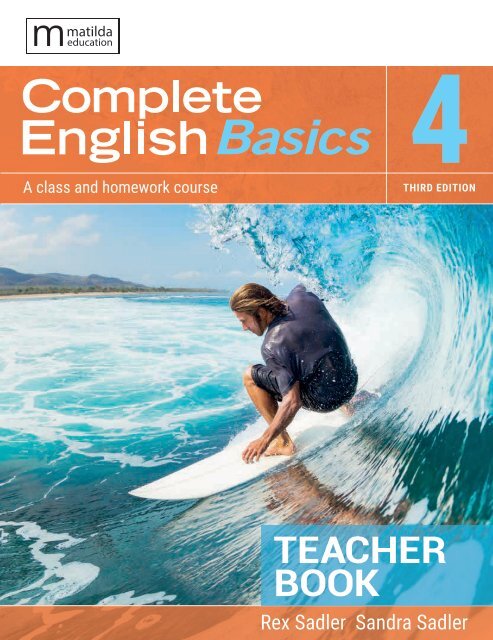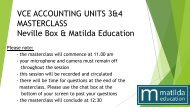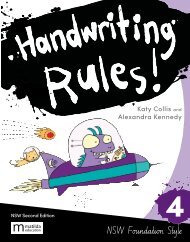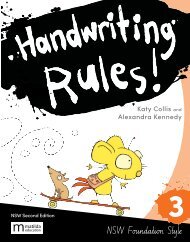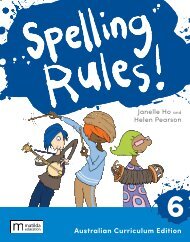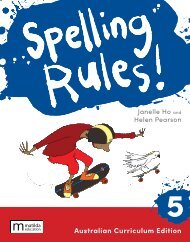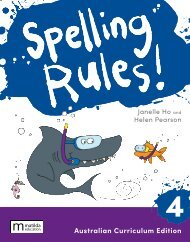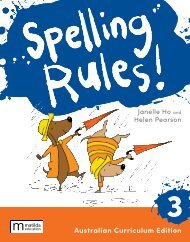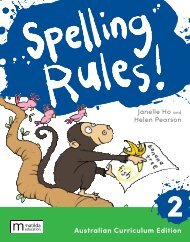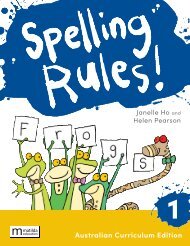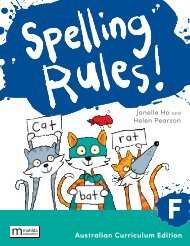Complete English Basics 4 Teacher Book
Complete English Basics is a workbook designed to support junior to middle secondary students with essential language and literacy skills. Highly structured units are organised into sections on comprehension, spelling and vocabulary, language, punctuation and writing, making the book ideal for both classwork and homework. Exercises are contextualised through high-interest topics that will fully engage students' attention. The book also features a wide variety of activity types clear, concise explanations of grammar and punctuation rules sequential development of language skills. This third edition includes additional content on writing, updated extracts and a new design. It also includes additional worksheets, plus answers, accessed via the digital download code in each Teacher Book in the categories: Literature, Spelling and Vocabulary, Language, and The Craft of Writing, mimicking the structure of the print books.
Complete English Basics is a workbook designed to support junior to middle secondary students with essential language and literacy skills. Highly structured units are organised into sections on comprehension, spelling and vocabulary, language, punctuation and writing, making the book ideal for both classwork and homework. Exercises are contextualised through high-interest topics that will fully engage students' attention. The book also features a wide variety of activity types clear, concise explanations of grammar and punctuation rules sequential development of language skills. This third edition includes additional content on writing, updated extracts and a new design. It also includes additional worksheets, plus answers, accessed via the digital download code in each Teacher Book in the categories: Literature, Spelling and Vocabulary, Language, and The Craft of Writing, mimicking the structure of the print books.
You also want an ePaper? Increase the reach of your titles
YUMPU automatically turns print PDFs into web optimized ePapers that Google loves.
4<br />
A class and homework course<br />
THIRD EDITION<br />
TEACHER<br />
BOOK<br />
Rex Sadler Sandra Sadler
4<br />
A class and homework course<br />
THIRD EDITION<br />
TEACHER<br />
BOOK<br />
Rex Sadler Sandra Sadler
This edition published in 2021 by<br />
Matilda Education Australia, an imprint<br />
of Meanwhile Education Pty Ltd<br />
Level 1/274 Brunswick St<br />
Fitzroy, Victoria Australia 3065<br />
T: 1300 277 235<br />
E: customersupport@matildaed.com.au<br />
www.matildaeducation.com.au<br />
First edition published in 2007 by Macmillan Science and Education Australia Pty Ltd<br />
Copyright © Rex Sadler and Sandra Sadler 2007, 2010, 2017<br />
The moral rights of the author have been asserted.<br />
All rights reserved.<br />
Except under the conditions described in the<br />
Copyright Act 1968 of Australia (the Act) and subsequent amendments,<br />
no part of this publication may be reproduced,<br />
stored in a retrieval system, or transmitted in any form or by any means,<br />
electronic, mechanical, photocopying, recording or otherwise,<br />
without the prior written permission of the copyright owner.<br />
Educational institutions copying any part of this book<br />
for educational purposes under the Act must be covered by a<br />
Copyright Agency Limited (CAL) licence for educational institutions<br />
and must have given a remuneration notice to CAL.<br />
Licence restrictions must be adhered to. For details of the CAL licence, contact:<br />
Copyright Agency Limited, Level 11, 66 Goulburn Street, Sydney, NSW 2000.<br />
Telephone: (02) 9394 7600. Facsimile: (02) 9394 7601. Email: memberservices@copyright.com.au<br />
Publication data<br />
Authors: Rex Sadler and Sandra Sadler<br />
Title: <strong>Complete</strong> <strong>English</strong> <strong>Basics</strong> 4 <strong>Teacher</strong> <strong>Book</strong>: A Class and Homework Course<br />
ISBN: 978 1 4202 3715 3<br />
Publisher: Emma Cooper<br />
Project editor: Barbara Delissen<br />
Cover and text designer: Dim Frangoulis<br />
Production control: Janine Biderman<br />
Photo research and permissions clearance: Annthea Lewis, Katy Murenu and Vanessa Roberts<br />
Typeset in Heuristica Regular 10.5/12pt by DiZign Pty Ltd<br />
Cover image: Adobe Stock/Olga Khoroshunova<br />
Printed in by <br />
1 2 3 4 5 6 7 25 24 23 22 21 20<br />
Warning: It is recommended that Aboriginal and Torres Strait Islander peoples exercise caution<br />
when viewing this publication as it may contain images of deceased persons
Contents<br />
Prefacevii<br />
Acknowledgementsviii<br />
1 The world of texts 1<br />
Comprehension Information report 1<br />
Film poster 3<br />
Poem 4<br />
Biography 5<br />
Spelling and vocabulary Communicating 6<br />
Language Text types 7<br />
Tone 8<br />
Euphemism 9<br />
The craft of writing An encounter 10<br />
2 Context11<br />
Comprehension Modern society 11<br />
Of peace and war 12<br />
Spelling and vocabulary Life and times 14<br />
Language Understanding sentences 15<br />
Subject and predicate 16<br />
The craft of writing Text and context 17<br />
3 Related texts—outlaws 19<br />
Comprehension Film review 19<br />
Novel 22<br />
Cartoon 24<br />
Spelling and vocabulary Freedom and justice 25<br />
Language Prefixes 26<br />
Suffixes 27<br />
The craft of writing Script layout 27<br />
4 Journeys29<br />
Comprehension The rabbit-proof fence 29<br />
Death by lethal seashells 31<br />
Spelling and vocabulary Out and about 33<br />
Language Nouns 34<br />
Common and proper nouns 34<br />
The craft of writing Journeys 36<br />
978 1 4202 3715 3<br />
iii
iv Contents<br />
978 1 4202 3715 3<br />
5 Autobiography37<br />
Comprehension Crash landing 37<br />
Grandad 39<br />
Spelling and vocabulary Endurance 40<br />
Language Collective nouns 42<br />
Abstract nouns 43<br />
The craft of writing Personal recounts 43<br />
6 Persuasion45<br />
Comprehension Advertisement 45<br />
Newspaper article 47<br />
Spelling and vocabulary Powers of persuasion 48<br />
Language Using bias 49<br />
The craft of writing A letter of complaint 51<br />
7 The poet’s world 53<br />
Comprehension School social 53<br />
The tourists 54<br />
Spelling and vocabulary Appreciating poetry 56<br />
Language Imagery 57<br />
The craft of writing Writing your own poems 59<br />
8 Biography61<br />
Comprehension Survival in the jungle 61<br />
Spelling and vocabulary Triumph over adversity 63<br />
Language Singular and plural nouns 64<br />
Irregular plurals 65<br />
The craft of writing Famous lives 65<br />
9 Genres67<br />
Comprehension Horror 67<br />
Fantasy 69<br />
Spelling and vocabulary Genres in action 70<br />
Language Adjectives 72<br />
The craft of writing Genres—creatures and characters 73<br />
10 Winning75<br />
Comprehension The pep talk 75<br />
Spelling and vocabulary Winners and losers 77<br />
Language Formal language 78<br />
Colloquial language 79<br />
The craft of writing Winning speeches 81<br />
11 Visual texts 83<br />
Comprehension Film still 83<br />
Cartoon 84<br />
Comic strip 85<br />
Spelling and vocabulary All about visual texts 87<br />
Language Confusing word pairs 88<br />
The craft of writing Storyboards 90
978 1 4202 3715 3 Contents<br />
v<br />
12 Humour91<br />
Comprehension Caricature 91<br />
Satire 92<br />
Comic strip 94<br />
Spelling and vocabulary Having a laugh 95<br />
Language Communication breakdown 97<br />
Ambiguity 97<br />
Circumlocution 99<br />
The craft of writing Creating humour 100<br />
13 Prejudice101<br />
Comprehension Characters in conflict 101<br />
Spelling and vocabulary Discrimination 103<br />
Language Shades of meaning 104<br />
The craft of writing Novel activities 106<br />
14 A world in conflict 107<br />
Comprehension The fury of war 107<br />
Landmines 109<br />
Spelling and vocabulary At war 111<br />
Language Verbs in action 112<br />
The craft of writing Voices from the front 114<br />
15 Inferno!115<br />
Comprehension Fighting the fire 115<br />
Spelling and vocabulary Struggle for survival 117<br />
Language Present participles 118<br />
Varying sentences 119<br />
The craft of writing Describing a dangerous situation 120<br />
16 Reviews121<br />
Comprehension Film reviews 121<br />
<strong>Book</strong> review 124<br />
Spelling and vocabulary A critical eye 125<br />
Language More confusing word pairs 126<br />
The craft of writing Writing book reviews 127<br />
17 William Shakespeare 129<br />
Comprehension A brief history 129<br />
All the world’s a stage 131<br />
Spelling and vocabulary Stage, screen and script 133<br />
Language Figurative language 135<br />
Metaphors 135<br />
Hyperbole 136<br />
The craft of writing The interview 137
vi <strong>Complete</strong> <strong>English</strong> <strong>Basics</strong> 4<br />
978 1 4202 3715 3<br />
18 People and places 139<br />
Comprehension Big brother 139<br />
007 meets Goldfinger 141<br />
Spelling and vocabulary All about people 143<br />
Language People in action 144<br />
The craft of writing Positioning characters 145<br />
19 The newspaper 147<br />
Comprehension Ocean ghosts wait for the unwary 147<br />
Spelling and vocabulary Meet the press 149<br />
Language Confusing endings 151<br />
Using better <strong>English</strong> 152<br />
The craft of writing Letters to the Editor 153<br />
20 Family matters 155<br />
Comprehension Recollections 155<br />
Spelling and vocabulary The family 157<br />
Language Personal pronouns 158<br />
Subject and object pronouns 159<br />
The craft of writing A self-portrait 159<br />
21 Superheroes161<br />
Comprehension Superman 161<br />
Spelling and vocabulary All about heroes 163<br />
Language Revising subjects and verbs 164<br />
The craft of writing A profile of a superhero 165<br />
22 Personal recount 167<br />
Comprehension Refugees in peril 167<br />
Spelling and vocabulary In character 168<br />
Language Revising parts of speech 170<br />
The craft of writing Choosing a point of view 171<br />
Back-of-the-book dictionary 173
Preface<br />
<strong>Complete</strong> <strong>English</strong> <strong>Basics</strong> 4 sets out to present essential <strong>English</strong> skills in an interesting and<br />
meaningful way for middle secondary students.<br />
This third edition covers essential language and literacy skills underpinning the<br />
new Australian Curriculum. Additional high-interest literacy texts have been added for<br />
comprehension and analysis.<br />
The workbook can be used as a class or homework text. One approach would be to have<br />
students complete each unit over a two-week period.<br />
The stimulus materials and exercises are designed to improve comprehension and<br />
vocabulary skills, as well as language usage and spelling. A special feature is the back-ofthe-book<br />
dictionary, which encourages students to expand their vocabulary by looking up the<br />
meanings of unfamiliar words.<br />
Correct spelling is essential for good communication. Research has shown that in those<br />
classrooms where teachers are concerned about correct spelling and vocabulary enrichment,<br />
the students’ spelling level improves significantly. It is a good idea, if time allows, to have a<br />
brief spelling test at the end of each unit using the words from the spelling and vocabulary list.<br />
The extracts are engaging and cover a diverse range of topics—from superheroes to<br />
Shakespeare. A range of genres is represented, including autobiography, science fiction,<br />
humour and romance.<br />
Above all, we hope that students will enjoy their studies as they gain basic <strong>English</strong> skills.<br />
Rex and Sandra Sadler<br />
978 1 4202 3715 3<br />
vii
Acknowledgements<br />
The author and publisher are grateful to the following for permission to reproduce copyright material:<br />
PHOTOGRAPHS<br />
Alamy Stock Photo/AF Archive, 73, 121, 123, 129, 161, /Granger<br />
Historical Picture Archive, 139, /Phil Gribbon, 147, /movies, 3, /<br />
Pictorial Press Ltd, 165; Australian War Memorial/AWM 127971<br />
(Still from AWM film F01866 ‘Assault on Salamaua’, newsreel by<br />
Damien Parer), 114; Taronga Zoo advertisement, reproduced<br />
with permission of Conservation Society Australia, 45; Getty<br />
Images/DigitalVision/Carl Roessler, 47, /John D. Kisch/Separate<br />
Cinema Archive, 29, /Silver Screen Collection, 17, /Warner Bros.,<br />
22; iStock/Mie Ahmt, 171, /Yuri_Arcurs, 82, /Ruvan Boshoff, 27,<br />
/Lisa Davis, 75, /Steve Debenport, 77, /Roger De Marfà, 54, /<br />
edelmar, 1, /encrier, 106, /franckreporter, 143, /Jose Girarte, 137,<br />
/Justin Horrocks, 93, /bjones27, 90, /LanceB, 133, /Henrique<br />
NDR Martins, 31, /Nahhan, 70, /kevinruss, 168, /pixdeluxe, 33,<br />
/seraficus, 149, /Staras, 10, /Catherine Yeulet, 53, /Pierre Yu,<br />
12, /Peeter Viisimaa, 103; Newspix/News Ltd/Neil Eliot, 155;<br />
Shutterstock/Anyka, 14, /AVAVA, 125, /Ryan Rodrick Beiler, 25, /<br />
Natasha Breen, 56, /Ronald Caswell, 115, /Pavel Chagochkin,<br />
67, /Anthony Cooper, 5, /dreamerve, 154, /Everett Historical,<br />
107, /everst, 36, /Eric Gevaert, 4, hecke61, 39, /ID1974, 131, /<br />
jackweichen, 95, /kldy, 146, /Kletr, 40, /Mana Photo, 44, /<br />
Pictures/REX, 19, /REX/EON/Columbia, 141, /victorsaboya, 159,<br />
/Mariia Smeshkova, 59, /sportpoint, 63, /Tashatuvango, 51, /<br />
TebNad, 111, /REX/Walt Disney, 83, /wavebreakmedia, 163, /<br />
worldswildlifewonders, 58, /Vladimir Wrangel, 87, /Igor Zh, 120.<br />
OTHER MATERIAL<br />
Extract from Angela’s Ashes by Frank McCourt, 1996, reprinted by<br />
permission of Abner Stein (ROW print, e-book rights) 160; Extract<br />
and cover image from Secrets in the Fire by Henning Mankell,<br />
Allen & Unwin, 2000, reproduced with permission of Allen &<br />
Unwin, 109; Review of To Kill a Mockingbird by Steve Creedy,<br />
Weekend Australian, 3 May 2008, reproduced with permission of<br />
The Australian, 121-2; Extract from Down Under by Bill Bryson,<br />
published by Broadway <strong>Book</strong>s, 2000, reproduced with permission<br />
of Bill Bryson, 31; Extract from ‘The relative advantages of learning<br />
my language’ by Amy Choi from Growing up Asian in Australia,<br />
edited by Alice Pung, Black Inc, 2008, reproduced with permission<br />
of Amy Choi, 39-40; Cartoon from The Cobb <strong>Book</strong>: Cartoons by<br />
Ron Cobb, published by Wild & Woolley Pty Ltd, Sydney, 1975,<br />
reproduced with permission of Ron Cobb, 11; Poem ‘Children’<br />
from Showground Sketchbook and other Poems by Nancy Keesing,<br />
published by Angus & Robertson, 1968. By Arrangement with<br />
the Licensor, The Nancy Kessing Estate, c/- Curtis Brown (Aust)<br />
Pty Ltd, 13; Extract from Goldfinger by Ian Fleming, Hodder and<br />
Stoughton, 1959, reproduced with permission of Curtis Brown,<br />
141; Extract from My Family and Other Animals by Gerald Durrell,<br />
Penguin, 1959, reproduced with permission of the Durrell Wildlife<br />
Conservation Trust, 10; Article ‘Looking under the Hood’ by Leigh<br />
Paatsch, The Daily Telegraph, May 13 2010, reproduced with<br />
permission of The Daily Telegraph, 20; Review of Romeo + Juliet by<br />
John Spence, Daily Telegraph, 12 November 2008, reproduced with<br />
permission of The Daily Telegraph, 123; Extract from The Chronicles<br />
of Robin Hood by Rosemary Sutcliff, Oxford University Press, 1978,<br />
reproduced with permission of David Higham and Associates,<br />
22-3; Extract from Going Solo by Roald Dahl, Jonathan Cape, 1986,<br />
reproduced with permission of David Higham and Associates, 37-8;<br />
Extract from article ‘Ocean ghosts wait for the unwary’ by Emma<br />
Blacklock, Sydney Morning Herald, 15 October 2008, reproduced<br />
with permission of Fairfax Media, 147-8; Extract from My Place by<br />
Sally Morgan, Fremantle Arts Centre Press, 1987, reproduced with<br />
permission of Fremantle Press, 155-6; Extract and illustration from<br />
Horrible Humans: A Field Guide by Max Dann and Peter Viska, 1987,<br />
Lothian <strong>Book</strong>s, reproduced with permission of Hachette Australia<br />
Pty Ltd, 91; Extract from ‘And My Heart Soars’, The Best of Chief Dan<br />
George by Chief Dan George and Helmut Hirnschall, reproduced<br />
with permission of the Hancock Wildlife Foundation, 8; Cover of<br />
Eco-Warrior by Skye Bortoli, ABC <strong>Book</strong>s, 2008, reproduced with<br />
permission of HarperCollins Publishers Australia, 127; Extract from<br />
Angela’s Ashes by Frank McCourt, 1996, reprinted by permission<br />
of HarperCollins Publishers Ltd. © 1996 Frank McCourt (World ex<br />
USA print rights), 160; Cartoon © Michael Leunig, 84; Interview<br />
‘Q&A Love your Work’ by Chris Sheedy, Sun Herald Sunday Life,<br />
9 April 2006, reproduced with permission of News Ltd, 137-8;<br />
Extract from Nineteen Eighty-Four by George Orwell (Copyright<br />
© George Orwell, 1949) Reprinted by permission of Bill Hamilton<br />
as the Literary Executor of the Estate of the Late Sonia Brownell<br />
(print rights), 139-40; Cover of Going Solo by Roald Dahl, Jonathan<br />
Cape, 1986, reproduced with permission of Penguin <strong>Book</strong>s, 37;<br />
Cover of Lockie Leonard, Legend by Tim Winton, Pan Macmillan,<br />
1997, reproduced with permission of Penguin Random House, 66;<br />
Extract from Brisingr: Inheritance, <strong>Book</strong> III by Christopher Paolini,<br />
2008. Used by permission of Alfred A Knopf, an imprint of Random<br />
House Children’s <strong>Book</strong>s, a division of Penguin Random House<br />
LLC. All rights reserved, 69; Extract from Nineteen Eighty-Four<br />
by George Orwell, 1949, reproduced with permission of Penguin<br />
Random House (e-book rights), 139-40; Extract and cover image<br />
from Looking for Alibrandi by Melina Marchetta, Penguin <strong>Book</strong>s<br />
Australia, 1992, reproduced with permission of Penguin Random<br />
House, 101-2; Cartoon ‘Weather terrific …’ by Mike Williams ©<br />
Punch Limited, 24; Eldest cover artwork © John Jude Palencar,<br />
from Eldest by Christopher Paolini. Published by Corgi Childrens.<br />
Reprinted by permission of The Random House Group Limited,<br />
124; Extract from All Quiet on the Western Front by Erich Maria<br />
Remarque, Heinemann UK, 1929, reproduced by permission of<br />
the Estate of the Late Paulette Goddard Remarque, 107-8; Poem<br />
‘The Tourists’ by John Rice, reprinted with permission of the<br />
author, 54-5; Extract from Follow the Rabbit-proof Fence by Doris<br />
Pilkington, published by University of Queensland Press, 1996,<br />
reproduced with permission of University of Queensland Press, 29-<br />
30; Extract from Red Golf Balls by Laurine Croasdale, published by<br />
University of Queensland Press, 1998, reproduced with permission<br />
of University of Queensland Press, 115-6; Extracts and cover image<br />
from The Rugmaker of Mazar-e-Sharif, by Najaf Mazari, Insight<br />
Publications, 2008, reproduced by permission of Wild Dingo<br />
Press, 167.<br />
The author and publisher would like to acknowledge<br />
the following:<br />
Poem ‘School social’ by BA Breen, 53; Extract from My Simple<br />
Little Brother by Lilith Norman, Collins, 1979, 100; Review of The<br />
Inheritance Trilogy: Eldest, The Daily Telegraph, Weekend magazine,<br />
21–22 July 2007, 124; Review of Eco-Warrior by Lucy Clark, The<br />
Sunday Telegraph, ‘Insider - <strong>Book</strong>s’ section, 21 September 2008,<br />
127; Extract from My Steve by Terri Irwin, Simon and Schuster, 2008,<br />
5; Snake comic strips www.snakecartoons.com, 85, 94; Extract from<br />
A Dagg at My Table by John Clarke, Text Publishing, 1998, 93.<br />
While every care has been taken to trace and acknowledge copyright, the publisher tenders their apologies for any accidental infringement<br />
where copyright has proved untraceable. They would be pleased to come to a suitable arrangement with the rightful owner in each case.<br />
viii 978 1 4202 3715 3
The world<br />
of texts<br />
1<br />
Comprehension<br />
Read and view the following texts and answer the questions.<br />
Information report<br />
The cane toad<br />
IN THE 1930s, sugarcane crops in Queensland<br />
were being destroyed by infestations of cane<br />
beetles. To try to combat the beetle, cane toads<br />
were introduced from Central and South America<br />
in 1935. This attempt to eradicate the beetle was<br />
unsuccessful, and now the cane toad has become<br />
a serious threat to native animals, humans and<br />
their pets.<br />
Cane toads have spread throughout Queensland,<br />
northern New South Wales and the<br />
Northern Territory. They are prolific breeders<br />
and adapt to many different environments. Each<br />
season, the female lays thousands of black eggs<br />
in long, sticky strands, which then attach to<br />
water plants, etc. Because cane toads produce<br />
a poison—even at the egg and tadpole stages—<br />
they can cause the water in which they live to<br />
become polluted. This can have a deleterious<br />
effect on native frogs and other water creatures.<br />
Both the male and female toads are heavily<br />
built and can weigh up to 2.5 kilograms. They<br />
have thick, leathery skin with wart-like bumps.<br />
The male toad has more bumps on his skin than<br />
the female. Cane toads have been known to<br />
reach an age of up to 16 years.<br />
As the toads grow, they threaten the survival of<br />
many native animals. Their venom (bufotoxin) is<br />
produced in two glands on the head behind the<br />
ears. It is toxic if ingested and extremely painful<br />
if it is rubbed into the eyes. The bufotoxin exudes<br />
over the cane toad’s body when it is frightened or<br />
squeezed. This causes predators such as snakes,<br />
goannas, freshwater crocodiles and egrets to be<br />
affected by the toxin when they try to eat the<br />
toads. Affected animals suffer profuse salivation,<br />
foaming at the mouth, violent vomiting and even<br />
death.<br />
Cane toads survive in many environments<br />
because they can live on a varied diet of dead or<br />
living plants, household rubbish, insects, frogs,<br />
small reptiles and mammals, and even pet food.<br />
If they do invade private properties, they often<br />
like to rest in pets’ water bowls, poisoning the<br />
water and causing health problems for domestic<br />
animals.<br />
The population of some native animals was<br />
dramatically reduced when cane toads were<br />
978 1 4202 3715 3<br />
1
2 <strong>Complete</strong> <strong>English</strong> <strong>Basics</strong> 4<br />
978 1 4202 3715 3<br />
first introduced, but over the years many native<br />
animals have learned not to include the toad in<br />
their diet.<br />
There are no known predators of the cane<br />
toad. Viruses that keep the cane toad numbers<br />
under control in its native Venezuela are lethal to<br />
Australia’s native frogs. One of the best ways of<br />
reducing the population of toads is to destroy the<br />
eggs and tadpoles before they mature.<br />
The Queensland government has suggested<br />
a humane way of killing adult cane toads. The<br />
toad should be caught with care and placed in a<br />
plastic bag. The bag should be tied and placed<br />
in the refrigerator for an hour to make the toad<br />
comatose. Then the bag should be placed in the<br />
freezer compartment for a minimum of sixteen<br />
hours. The dead toad can then be buried or put<br />
into a compost heap.<br />
Reading for understanding<br />
1 Why was the cane toad brought to Queensland from Central and South America in 1935?<br />
They were introduced to combat the cane beetles which were destroying the sugarcane<br />
crops.<br />
2 Give two reasons for the rapid spread of the cane toad in Queensland.<br />
They are prolific breeders and adapt to many different environments.<br />
3 How does the cane toad—even at the egg and tadpole stages—endanger native frogs and<br />
other water creatures?<br />
It produces a poison that may pollute the water.<br />
4 How does the cane toad become dangerous to predators when it is frightened?<br />
Its venom (bufotoxin) spreads all over its body and makes the cane toad poisonous to eat.<br />
5 How does the diet of the cane toad enable it to survive in many environments?<br />
The cane toad is able to survive on a wide variety of dead and living things.<br />
6 What is one of the best ways of preventing the cane toad from reaching maturity?<br />
One of the best ways is to destroy the eggs and tadpoles before they mature.<br />
7 Why is the cane toad population under control in Venezuela but not in Australia?<br />
In Venezuela, viruses keep cane toad numbers under control. These viruses can’t be used in <br />
Australia because they kill native frogs.<br />
8 Use the back-of-the-book dictionary to find the meanings of these words:<br />
a eradicate: to get rid of completely<br />
b prolific: abundant; producing a lot<br />
c deleterious: harmful; injurious to health<br />
d ingest: to take food into the body<br />
e predator: an animal that hunts other animals for food<br />
f comatose: lethargic; unconscious<br />
13 marks
978 1 4202 3715 3<br />
1 The world of texts 3<br />
Film poster<br />
Titanic<br />
Reading for understanding<br />
1 What is the purpose of this film poster?<br />
Its purpose is to persuade people to go and see the film Titanic.<br />
2 What techniques has the advertiser used to show that the movie’s focus is the love<br />
between the two young people?<br />
The enlarged faces of the two lovers are positioned together above the ship, and the words<br />
‘Nothing on earth could come between them’ reveal the intense love they have for each other.<br />
<br />
3 Why do you think the names of the two main actors are on the poster?<br />
They are famous and accomplished actors who are popular with audiences. <br />
<br />
4 What impression does the poster give of the ship?<br />
The poster conveys the great size and power of the Titanic.<br />
5 Why is the audience positioned below the subject of the poster?<br />
The might of the ship and the characters’ love for each other is emphasised.<br />
<br />
5 marks
4 <strong>Complete</strong> <strong>English</strong> <strong>Basics</strong> 4<br />
978 1 4202 3715 3<br />
Poem<br />
The panther<br />
His weary glance, from passing by the bars,<br />
Has grown into a dazed and vacant stare;<br />
It seems to him there are a thousand bars<br />
And out beyond those bars the empty air.<br />
The pad of his strong feet, that ceaseless sound<br />
Of supple tread behind the iron bands,<br />
Is like a dance of strength circling around,<br />
While in the circle, stunned, a great will stands.<br />
But there are times the pupils of his eyes<br />
Dilate, the strong limbs stand alert, apart,<br />
Tense with the flood of visions that arise<br />
Only to sink and die within his heart.<br />
Rainer Maria Rilke<br />
Reading for understanding<br />
1 Why is the panther’s glance ‘weary’?<br />
He is weary because he is constantly pacing behind the bars of his cage.<br />
2 Which words in the first stanza suggest that there is an impossible barrier to freedom?<br />
‘… a thousand bars’<br />
3 How does the poet use alliteration in the second stanza to suggest the panther’s<br />
movements?<br />
The alliteration of the ‘s’ throughout the second stanza suggests the movements of the<br />
panther.<br />
4 Which words show that the panther is a powerful animal?<br />
‘The pad of his strong feet’, ‘like a dance of strength’, ‘strong limbs’.<br />
5 Explain the meaning of ‘stunned, a great will stands’.<br />
Even though the panther is determinedly seeking to gain his freedom, he is restricted by<br />
‘a thousand bars’.<br />
6 What do you think ‘the flood of visions’ could be?<br />
‘… the flood of visions’ evokes the panther’s life of freedom in the natural world.<br />
7 Explain how the poem ends in a message of despair.<br />
The last line shows the panther’s despair of ever achieving freedom.<br />
8 What is the poet’s purpose in writing this poem?<br />
The purpose is to show the terrible effect on a wild animal such as a panther held in captivity. <br />
<br />
8 marks
978 1 4202 3715 3<br />
1 The world of texts 5<br />
Biography<br />
Encounter with a crocodile<br />
IT WENT like clockwork. Steve top-jaw roped<br />
Toolakea, and we all jumped her. He decided<br />
since she was only a little over nine feet long, we<br />
would be able to just lift her over the fence and<br />
carry her to her other enclosure.<br />
Steve never built his enclosures with gates.<br />
He knew that, sooner or later, someone would<br />
make a mistake and not latch a gate properly. We<br />
had to be masters at fence jumping. He picked<br />
up Toolakea around her shoulders with her neck<br />
held firmly against his upper arm. This would<br />
protect his face if she started struggling. The rest<br />
of us backed him up and helped to lift Toolakea<br />
over the fence.<br />
All of a sudden she exploded, twisting and<br />
writhing.<br />
‘Down, down, down,’ Steve shouted. That<br />
was our signal to pin the crocodile again before<br />
picking her up. Not everyone reacted quickly<br />
enough. As Steve moved to the ground, the<br />
people on the tail were still standing up. That<br />
afforded Toolakea the opportunity to twist her<br />
head around and grab hold of Steve’s thigh.<br />
The big female croc sunk her teeth deep into<br />
his flesh. I never realised it until later. Steve<br />
didn’t flinch. He settled the crocodile on the<br />
ground, keeping her eyes covered to quiet her<br />
down. We lifted her again. This time she cleared<br />
the fence easily. I noticed the blood trickling<br />
down Steve’s leg.<br />
We got to the other enclosure before I asked<br />
what had happened, and he showed me. There<br />
were a dozen tears in the fabric of his khaki<br />
shorts. Half-a-dozen of Toolakea’s teeth had<br />
got through to his flesh, putting a number of<br />
puncture holes in his upper thigh.<br />
from My Steve by Terri Irwin<br />
Reading for understanding<br />
1 Why did Steve decide that they would be able to lift Toolakea over the fence?<br />
Toolakea was only a little over nine feet long.<br />
2 Why hadn’t Steve built his enclosures with gates?<br />
Steve believed that someone would fail to latch a gate properly and cause a crocodile to <br />
escape.<br />
3 What afforded Toolakea the opportunity to grab hold of Steve’s thigh?<br />
The people holding the tail failed to move to the ground quickly enough.<br />
4 Why was the narrator at first unaware that Steve had been bitten?<br />
Steve did not flinch when he was bitten.<br />
5 How did Steve quieten down the crocodile?<br />
Steve kept Toolakea’s eyes covered.<br />
6 What evidence was there to show that Steve had received a dangerous bite?<br />
Blood was trickling down his leg, his shorts were torn and some of Toolakea’s teeth had put <br />
puncture holes in Steve’s upper thigh.<br />
7 What does this incident reveal about the character of Steve Irwin?<br />
Steve was quick-thinking, unafraid and reacted quickly to a dangerous situation.<br />
7 marks
6 <strong>Complete</strong> <strong>English</strong> <strong>Basics</strong> 4<br />
978 1 4202 3715 3<br />
Spelling and vocabulary<br />
Communicating<br />
illustrate entertain criticise description persuade<br />
review comparison complaint argue analyse<br />
evaluate condemn response interjection influence<br />
predict advertise invitation clarify request<br />
directory approve applause definition exhibition<br />
explain discussion introduce information summarise<br />
A word for a phrase<br />
Find words in the spelling list that match the meanings of the following phrases. The first letter<br />
of each word is given to help you.<br />
1 a talk in which opinions are shared d discussion<br />
2 an expression of dissatisfaction c complaint<br />
3 a reply r response<br />
4 to interest and amuse e entertain<br />
5 a remark made to interrupt a conversation or speech i interjection<br />
6 praise or approval expressed by handclapping a applause<br />
7 a representation by written or spoken words d description<br />
8 to make clear c clarify<br />
9 to examine in detail a analyse<br />
10 to make known for the first time i introduce<br />
11 a likening that shows similarities or differences c comparison<br />
12 to convince or make someone believe p persuade<br />
13 the power to affect people, actions or events i influence<br />
14 to outline the main points s summarise<br />
Word forms<br />
Form nouns from the verbs in brackets to complete the phrases.<br />
1 heated argument (argue) 7 severe condemnation (condemn)<br />
2 course evaluation (evaluate) 8 clear explanation (explain)<br />
3 scathing criticism (criticise) 9 brief summary (summarise)<br />
4 written approval (approve) 10 graphic illustration (illustrate)<br />
5 scientific analysis (analyse) 11 weather prediction (predict)<br />
6 brief introduction (introduce) 12 legal clarification (clarify)<br />
14 marks<br />
12 marks
978 1 4202 3715 3<br />
1 The world of texts 7<br />
Back-of-the-book dictionary<br />
The word ‘interjection’ is derived from the Latin words inter, meaning<br />
‘between’, and iacere, meaning ‘to throw’. An interjection is literally<br />
‘a throwing between’. There are many words in the <strong>English</strong> language<br />
that are derived from inter. Use the back-of-the-book dictionary to<br />
write the meanings of the following inter words.<br />
intercede: to try to put an end to an argument on behalf of someone<br />
interloper: an intruder<br />
intermittent: stopping and starting<br />
interpose: to interrupt; to place between<br />
interrogate: to question closely<br />
Language<br />
5 marks<br />
Text types<br />
A text is a spoken, written or visual communication used to convey meaning to an audience. Five<br />
main categories of texts can be identified: factual texts, literary texts, visual texts, media texts<br />
and everyday texts. Well-known texts include novels, poems, newspaper articles, films, reviews,<br />
jokes, cartoons, comic strips, advertisements, emails, scripts, diaries, letters, paintings, posters,<br />
photographs, brochures and autobiographies.<br />
Identifying purpose and audience<br />
Write the purpose and audience for each of the following texts.<br />
1 A school report<br />
a<br />
b<br />
Purpose: To show how a student is progressing at school<br />
Audience: Student, parents and teachers<br />
2 A letter to the editor of a newspaper<br />
a<br />
b<br />
Purpose: To inform readers of an issue or problem<br />
Audience: Readers of the newspaper<br />
3 A car manual<br />
a<br />
b<br />
Purpose: To show how to operate a car<br />
Audience: Mechanic or owner<br />
4 A travel brochure about travelling to Alaska<br />
a<br />
b<br />
Purpose: To persuade travellers to go to Alaska<br />
Audience: People interested in travelling abroad<br />
5 Nursery rhymes<br />
a<br />
b<br />
Purpose: To entertain children<br />
Audience: Small children
8 <strong>Complete</strong> <strong>English</strong> <strong>Basics</strong> 4<br />
978 1 4202 3715 3<br />
6<br />
Tone<br />
A television guide<br />
a<br />
b<br />
Purpose: To give information about upcoming TV programs<br />
Audience: Television viewers<br />
7 The blurb on the back cover of a novel<br />
a<br />
b<br />
8 A film script<br />
a<br />
b<br />
Purpose: To provide information about the novel to entice the reader to purchase it<br />
Audience: Readers of novels<br />
Purpose: To provide words and directions for the actors and director<br />
Audience: Actors, directors, producers (and film students)<br />
16 marks<br />
The choice of words in a written text enables the writer to introduce certain attitudes and feelings;<br />
for example, angry, informative, ironical, gentle, sympathetic, critical, joyful. These attitudes and<br />
feelings form the tone of the text. It is through the writer’s tone that the emotional message of the<br />
text is communicated to the audience.<br />
Identifying tone<br />
Read the following passages and identify the tone in each one.<br />
1 ‘The strength of fire, the taste of salmon, the trail of the sun,<br />
And the life that never goes away,<br />
They speak to me.<br />
And my heart soars.’ (from And My Heart Soars by Chief Dan George)<br />
Tone: The tone is one of joy and exultation.<br />
2 ‘Give a man a fish; you have fed him for today. Teach a man to fish; and you have fed him<br />
for a lifetime.’ (Anonymous)<br />
Tone: The tone is wise, encouraging and positive.<br />
3 ‘The town had a black canal in it, and a river that ran purple with ill-smelling dye.’<br />
(from Hard Times by Charles Dickens)<br />
Tone: The tone is depressing and dismal.<br />
4 ‘Death of much-loved leader’ (Newspaper headline)<br />
Tone: The tone is one of respect, sadness and grief.<br />
5 ‘Troops without ammunition or food. 18,000 wounded without any supplies or dressings<br />
or drugs.’ (General von Paulus’s communiqué to Adolf Hitler)<br />
Tone: The tone is one of despair and hopelessness.<br />
6 I eat my peas with honey;<br />
I’ve done it all my life.<br />
It makes the peas taste funny,<br />
But it keeps them on the knife. (Anonymous)<br />
Tone: The tone of the poem is funny and light-hearted.<br />
6 marks
978 1 4202 3715 3<br />
1 The world of texts 9<br />
Euphemism<br />
A euphemism is a pleasant or mild expression used to replace one that is considered harsh or<br />
blunt. A coach driver, for example, might tell passengers of a ‘comfort stop’ rather than a toilet stop.<br />
Using euphemisms<br />
Rewrite the following sentences, replacing the term shown in italics with a suitable euphemism<br />
from the box.<br />
senior citizen pre-loved a custodial facility<br />
perspire between jobs waste disposal specialist<br />
dentures under the influence economically disadvantaged<br />
mobile home put to sleep courtesy reminder<br />
1 The lecturer purchased a second-hand computer online.<br />
The lecturer purchased a pre-loved computer online.<br />
2 The tenant received a warning for not paying the rent.<br />
The tenant received a courtesy reminder for not paying the rent.<br />
3 The old-age pensioner had lost his false teeth.<br />
The senior citizen had lost his dentures.<br />
4 The garbage collector found a valuable antique.<br />
The waste disposal specialist found a valuable antique.<br />
5 The poverty-stricken family had to live in a caravan.<br />
The economically disadvantaged family had to live in a mobile home.<br />
6 The thief was sentenced to five years in jail.<br />
The thief was sentenced to five years in a custodial facility.<br />
7 The racehorse with a broken leg had to be euthanised.<br />
The racehorse with a broken leg had to be put to sleep.<br />
8 The truck driver was arrested for driving while drunk.<br />
The truck driver was arrested for driving while under the influence.<br />
9 The television executive was now unemployed.<br />
The television executive was now between jobs.<br />
10 Soon after the start of the marathon, the runners began to sweat.<br />
Soon after the start of the marathon, the runners began to perspire.<br />
10 marks
10 <strong>Complete</strong> <strong>English</strong> <strong>Basics</strong> 4<br />
978 1 4202 3715 3<br />
The craft of writing<br />
An encounter<br />
In this unit you have read texts describing<br />
the cane toad, a panther and a crocodile. The<br />
extract below is from a true encounter that<br />
Gerald Durrell had with a pod of dolphins while<br />
swimming in a bay off the island of Corfu.<br />
Swimming with porpoises<br />
… some twenty feet away from me, the sea<br />
seemed to part with a gentle swish and gurgle,<br />
a gleaming back appeared, gave a deep satisfied<br />
sigh, and sank below the surface again. I had<br />
hardly time to recognize it as a porpoise before<br />
I found I was right in the midst of them. They<br />
rose all around me, sighing luxuriously, their<br />
black backs shining as they humped in the<br />
moonlight. There must have been about eight<br />
of them, and one rose so close that I could have<br />
swum forward three strokes and touched his<br />
ebony head. Heaving and sighing heavily, they<br />
played across the bay, and I swam with them,<br />
watching fascinated as they rose to the surface,<br />
crumpling the water, breathed deeply, and then<br />
dived beneath the surface again, leaving only<br />
an expanding hoop of foam to mark the spot.<br />
Presently, as if obeying a signal, they turned and<br />
headed out of the bay towards the distant coast<br />
of Albania, and I trod water and watched them<br />
go, swimming up the white chain of moonlight,<br />
backs agleam as they rose and plunged with<br />
heavy ecstasy in the water as warm as fresh milk.<br />
Behind them they left a trail of great bubbles that<br />
rocked and shone briefly like miniature moons<br />
before vanishing under the ripples.<br />
from My Family and Other Animals by Gerald Durrell<br />
Describing an animal encounter<br />
Using any kind of text you like, describe an interesting animal encounter. Your description may<br />
be factual or fictional. One of the following creatures might interest you.<br />
family pet dog cat octopus ants spider kangaroo<br />
crocodile vulture whale shark horse mouse seal
Context<br />
2<br />
Comprehension<br />
View and read the following texts, then answer the questions. Each text has a short introduction to<br />
place it in context.<br />
Modern society<br />
Ron Cobb has won fame as a political cartoonist, artist, writer and film designer. As a film designer,<br />
he has been involved in the production of popular science fiction films such as Star Wars, Back to the<br />
Future and Aliens. In his cartoons he ridicules and condemns the behaviour of modern society.<br />
978 1 4202 3715 3<br />
11
12 <strong>Complete</strong> <strong>English</strong> <strong>Basics</strong> 4<br />
978 1 4202 3715 3<br />
Reading for understanding<br />
1 What comment about modern living is Ron Cobb making in the cartoon?<br />
Ron Cobb is showing that by creating a world of high-rise concrete buildings, we have<br />
abandoned nature.<br />
2 Why is the small plant important in this cartoon?<br />
The plant, small though it is, represents the world of nature. It gives happiness to the old<br />
man.<br />
3 What is the significance of the high-rise buildings?<br />
High-rise buildings are dominating human existence. They are a blot on the landscape.<br />
4 The old man appears happy and contented. Why is this?<br />
He is happy because he is able to see the beauty of nature.<br />
5 What evidence can you find to show that this is a modern-day cartoon?<br />
The style of the high-rise buildings give the impression that this is a contemporary cartoon.<br />
<br />
6 What attitude to life do you think Ron Cobb would recommend?<br />
Ron Cobb would certainly recommend that we should be closer to nature.<br />
7 Why are cartoonists such as Ron Cobb important in today’s society?<br />
The cartoonists use of humour to send strong messages about the follies of modern society.<br />
7 marks<br />
Of peace and war<br />
As the poem ‘Children’ begins, the poet, Nancy Keesing,<br />
is watching her children surfing at an Australian beach.<br />
It is the time of the Vietnam War, when the United<br />
States of America and Australia are fighting on the<br />
side of South Vietnam in a war against North Vietnam.<br />
Keesing is also reading a newspaper and sees horrifying<br />
pictures of innocent village children being blown apart<br />
in the conflict. While she has concerns for her own<br />
children being hurt by the occasional dumpers, she<br />
suffers anguish for the Vietnamese children who have<br />
become casualties of the war.
978 1 4202 3715 3<br />
2 Context 13<br />
Children<br />
Long-summer scorched, my surfing children<br />
Catch random waves or thump in dumpers,<br />
Whirling, gasping, tossed, disjointed.<br />
I, watching, fear they may be broken—<br />
That all those foaming limbs will never<br />
Reassemble whole, together.<br />
All under such a peaceful sky.<br />
All under such another sky.<br />
The pictures show some village children<br />
Caught at random, tossed, exploded,<br />
Torn, disjointed, like sticks broken,<br />
Whose jagged scorching limbs will never<br />
Reassemble whole, together.<br />
Nancy Keesing<br />
Reading for understanding<br />
1 What is the setting as the poem begins?<br />
It is a hot summer’s day with waves breaking on the beach where the poet’s children are<br />
swimming.<br />
2 What does ‘long-summer scorched’ tell you about the poet’s children?<br />
The poet’s children have become sunburnt during the long summer.<br />
3 ‘… thump in dumpers’. What does the assonance suggest about the waves?<br />
The assonance suggests the destructive power and force of the waves.<br />
4 Why is the poet afraid for her children?<br />
She is afraid that the dumpers may seriously injure her children.<br />
5 How does the poet prepare the reader for a change of setting?<br />
In the middle of the poem, the two phrases identifying the Australian and Vietnamese<br />
locations are set apart from the rest of the poem.<br />
6 Explain the difference between ‘Catch random waves’ and ‘Caught at random’.<br />
The first image depicts children catching waves for surfing, while the second shows children <br />
caught up and being killed senselessly in war.<br />
7 Why are village children ‘disjointed, like sticks broken’?<br />
The village children are blown apart by the weapons of war.<br />
8 Explain the difference in the poem between ‘foaming limbs’ and ‘jagged scorching<br />
limbs’.<br />
The ‘foaming limbs’ are those of the swimmers, while the ‘jagged scorching limbs’ are those<br />
of the Vietnamese children who have become casualties of war.<br />
<br />
9 What is the poet’s purpose in this poem?<br />
The poet’s purpose is to show the futility of children killed in war and how their tragic lives <br />
differ from children who live in a peaceful environment.<br />
9 marks
14 <strong>Complete</strong> <strong>English</strong> <strong>Basics</strong> 4<br />
978 1 4202 3715 3<br />
Spelling and vocabulary<br />
Life and times<br />
setting heritage values acknowledge controversy<br />
contemporary historical society customary significance<br />
literature culture permanent admiration debatable<br />
evidence belief recommend witness reputation<br />
recognition peculiar similarity tradition distinguished<br />
intellectual illustrious precede opinion civilisation<br />
A word for a phrase<br />
Find words in the spelling list that match the meanings of the following phrases. The first letter<br />
of each word is given.<br />
1 the time and place s setting<br />
2 to go before p precede<br />
3 modern; existing now c contemporary<br />
4 famous or distinguished i illustrious<br />
5 an argument or difference of opinion c controversy<br />
6 the handing down of beliefs or customs t tradition<br />
7 relating to the study of past events h historical<br />
8 books and other forms of writing l literature<br />
9 valuable things passed from one generation to the next h heritage<br />
10 information that gives reasons for believing something e evidence<br />
10 marks<br />
Completing the phrases<br />
<strong>Complete</strong> the phrases by adding suitable words from the spelling list. The first letters are given<br />
to help you. Use each word once only.<br />
1 a w witness for the defence 9 a close s similarity<br />
2 an i illustrious war record 10 a d debatable decision<br />
3 p peculiar behaviour 11 a second o opinion<br />
4 <strong>English</strong> l literature 12 of great s significance<br />
5 middle-class s society 13 religious b belief<br />
6 according to t tradition 14 a p permanent home<br />
7 the stage s setting 15 our national h heritage<br />
8 well-deserved r recognition 16 customs and v values<br />
16 marks
978 1 4202 3715 3<br />
2 Context 15<br />
Back-of-the-book dictionary<br />
The word ‘significance’ comes from the Latin word signum, which<br />
means a ‘sign’, ‘mark’ or ‘seal’. Below are some more <strong>English</strong> words<br />
derived from signum. Use the back-of-the-book dictionary to write<br />
their meanings.<br />
insignia: distinguishing marks<br />
signature: the name of a person written in his or her handwriting<br />
signet: a small sign or seal representing authority<br />
designate: to select; nominate or appoint<br />
signatory: one who signs with another in a joint agreement<br />
Language<br />
5 marks<br />
Understanding sentences<br />
A sentence is an arrangement of words that expresses a complete thought or idea. Below is an<br />
example of a simple sentence expressing a complete thought.<br />
The hallway smelt of boiled cabbage. (from Nineteen Eighty-Four by George Orwell)<br />
A sentence presents a subject (noun) and then reveals some information about it. The subject of<br />
the above sentence is ‘the hallway’. What is said about the hallway is that it ‘smelt of boiled cabbage’.<br />
This part is called the predicate of the sentence. Notice that the predicate contains the verb or<br />
action word ‘smelt’. To help you create complete sentences, each containing a complete thought, it is<br />
important to understand that sentences contain a subject and a predicate.<br />
Forming sentences<br />
Here are twelve sentences from the pens of famous novelists. The subjects have been removed<br />
from their predicates. <strong>Complete</strong> each sentence by inserting the correct subject from the list<br />
below.<br />
The old man The print of a man’s foot The unconscious patient<br />
Dinner The swarm of students The shark’s dorsal fin<br />
Three sailors A weak trickle of steam The poster with the huge face<br />
Her teeth The Grand Trunk Road The cave bear’s sacred bones<br />
1 The shark’s dorsal fin cut the glassy water with a hiss.<br />
( Jaws, Peter Benchley)<br />
2 Three sailors were the barest crew for a cutter.<br />
(Flying Colours, CS Forester)<br />
3 Her teeth were white in her brown face.<br />
(For Whom the Bell Tolls, Ernest Hemingway)<br />
4 The swarm of students vandalised the classroom.<br />
(The Blackboard Jungle, Evan Hunter)
16 <strong>Complete</strong> <strong>English</strong> <strong>Basics</strong> 4<br />
978 1 4202 3715 3<br />
5 The cave bear’s sacred bones were placed in the bear’s cave.<br />
(The Clan of the Cave Bear, Jean Auel)<br />
6 The poster with the huge face gazed from the wall.<br />
(Nineteen Eighty-Four, George Orwell)<br />
7 The unconscious patient had been in a motor accident.<br />
(One Pair of Feet, Monica Dickens)<br />
8 The old man was thin and gaunt with deep wrinkles.<br />
(The Old Man and the Sea, Ernest Hemingway)<br />
9 Dinner was handsomely served at a groaning table.<br />
(Bleak House, Charles Dickens)<br />
10 The Grand Trunk Road runs straight without crowding India’s<br />
traffic for fifteen hundred miles. (Kim, Rudyard Kipling)<br />
11 The print of a man’s foot was plain to be seen in the sand.<br />
(Robinson Crusoe, Daniel Defoe)<br />
12 A weak trickle of steam hissed from the engine’s outlet valve.<br />
(Puckoon, Spike Milligan)<br />
Subject and predicate<br />
12 marks<br />
When you consider the examples above and the ones that follow, you will notice that the subject of<br />
a sentence can be a single word or a group of words. The same rule applies to<br />
the predicate. To find the subject, it is a good idea to ask ‘who?’ or ‘what?’ before the verb.<br />
The verb (and any additional information relating to that verb) forms the predicate.<br />
Subject<br />
Shakespeare<br />
William Shakespeare, a famous dramatist,<br />
Predicate<br />
wrote plays.<br />
wrote tragedies, comedies and histories.<br />
It is also important to note that the subject does not always have to come at the beginning of a<br />
sentence. For example:<br />
At the beginning of his career, Shakespeare had been an actor.<br />
Identifying the subject and predicate<br />
Divide each sentence below into its subject and predicate.<br />
1 The rumbling of thunder was heard after the lightning flashes.<br />
Subject: The rumbling of thunder<br />
Predicate: was heard after the lightning flashes.<br />
2 The bushrangers bailed up the stagecoach at the top of the hill.<br />
Subject: The bushrangers<br />
Predicate: bailed up the stagecoach at the top of the hill.
978 1 4202 3715 3<br />
2 Context 17<br />
3 A Norwegian engineer named Erik Rotheim invented the aerosol can.<br />
Subject: A Norwegian engineer named Erik Rotheim<br />
Predicate: invented the aerosol can.<br />
4 High above the plains soared the wedge-tailed eagle.<br />
Subject: the wedge-tailed eagle.<br />
Predicate: High above the plains soared<br />
5 The head of the snake appeared through the undergrowth.<br />
Subject: The head of the snake<br />
Predicate: appeared through the undergrowth.<br />
6 In front of the explorers stood an escaped convict, thin and hungry.<br />
Subject: an escaped convict, thin and hungry.<br />
Predicate: In front of the explorers stood<br />
12 marks<br />
The craft of writing<br />
Text and context<br />
Texts are not created in isolation. Many personal, social, cultural, historical and natural influences<br />
and factors affect their creation.<br />
All texts are influenced in some way by the society and culture in which they are created.<br />
They reflect the values and attitudes of the time and place of their creation. These influences,<br />
together with the surrounding circumstances, background and setting of a text, are all part of its<br />
context.<br />
Your context as the reader of the text is also important. Your life experiences, values,<br />
education and background combine to determine how you react to a particular text.<br />
The following extract is an abridged version of what one student wrote about the background<br />
of the author Harper Lee and the context of her book To Kill a Mockingbird.<br />
Time and place<br />
In 1863, during the American Civil War, Abraham Lincoln issued<br />
a proclamation for the freeing of the slaves in the southern states<br />
of America. However, this did not provide equal status between<br />
the black people living in the South and the white people. Most<br />
black people were impoverished and received little education.<br />
The rigorous policy of segregation resulted in them being denied<br />
job opportunities and equal rights. In addition, thousands were<br />
lynched and terrorised by white people through organisations such<br />
as the Ku Klux Klan. It was only when the civil rights movement<br />
came to the fore in the 1960s that changes began to take place.<br />
Harper Lee, who was born on 28 April 1926, grew up in the<br />
small south-western town of Monroeville in Alabama. She was<br />
well aware of the legal and social injustices endured by the black<br />
people in the South. Her father—like Atticus Finch in the novel—<br />
was a lawyer and she had also studied law, but withdrew from<br />
the course six months before graduation.


